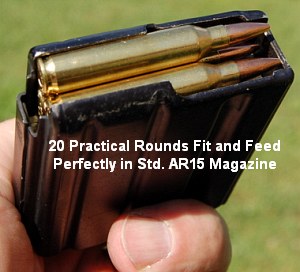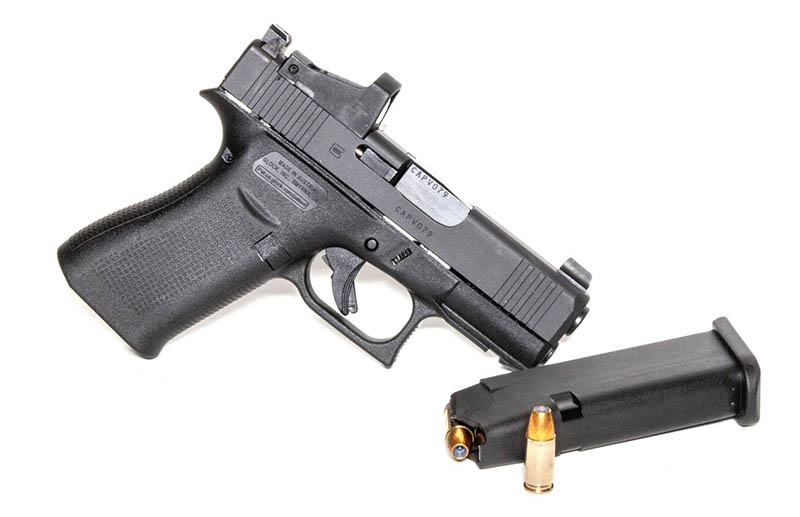My primary carry weapon is an old, lightweight Browning Hi Power. It was used by Novak’s. A good friend gave it to me. It’s easy to carry and I can shoot it well. The pistol is a very rare and valuable gun in dollars. However, it cannot be replaced. I travel a lot by air and I always carry a weapon with me, unless the host at my destination gives me one. I don’t want to give a baggage handler the chance to steal my Hi Power. I needed a moderately affordable, and most importantly–replaceable–carry gun that was dependable. This is how I ended up with the Glock G43XMOS. It’s a reliable carry gun with no emotional value, and it’s also replaceable. As a police officer and then as a special agent I had a Glock or similar handgun. I would also carry another Glock in an ankle holster that shared magazines with my duty handgun. I’m a Glock armorer, and I even won a GSSF sponsored shooting match. But the truth is I wasn’t enamored by the duty-size Glocks. Or the smaller G26 or G27 guns I carried on my ankle while working. I recently had the chance to handle a G43XMOS and was impressed by its compact size, 10+1 capacity, and the fact that it is optics ready. I bought one to use as my travel pistol. I have never liked the standard factory sights on Glock pistols. I think the front sight of a fighting gun should be a sight you can see clearly without having to look. I was looking for a mini reflex sight to fit the Glock G43XMOS slide. I didn’t need an adapter plate and wanted the XS R3D sight as a backup sight system. I had a Crimson Trace CTS-1550 compatible with the RMSc foot print on the G43X’s MOS slide. I chose that. The Suppressor Height R3D 2.0 Sights from XS Sights are an excellent redundant sight for the G43X. I chose the Galco Royal Guard Holster, which I have used for years. I also purchased a Galco Concealable magazine carrier. I tried something different for OWB – the Safariland Solis ALS holster. It’s a polymer paddle holster with a quick-release retention device and can be converted to belt-slot carrying. The thumb release retention device was a plus, as was the fact that the holster could accommodate a rail light. The holster would be suitable for carrying in cooler weather, even when wearing a jacket. Running the Step Back Drill on an 8-inch plate at 10 yards. I fired 500 rounds in two days. I used a mixture of practice ammo, and Federal’s Law Enforcement Tactical HydraShok 124-grain load, which I trust to carry. I was able to shoot the pistol well and the gun performed perfectly. The holsters, too, were excellent. I switched from the Concealable Magazine Carrier to the clip-on Galco QMC Mag pouch to be able to put it on and remove it without having to undo my belt. Glock’s G43X with Federal’s Law Enforcement’s 124-grain Hydra-Shock loads. I had worked with this drill for a long time and decided that it was great for establishing your shot cadence and developing basic marksmanship. It also served as a practical exercise using a defensive handgun. It’s a 10 round drill that starts at five yards and ends at twenty-five yards. It’s simple to set up and you can use it at any range. The G43X is a great option for concealed carry. You can use a target of 8 inches, such as the Thompson Target Halo 8-inch Target. You can also use a standard IDPA target with an 8-inch circle in the center or an 8 inch steel plate set at a slight angle to deflect bullets splatter towards the ground. You will also need your holster, gun, and eye/ear protection. You can either run the drill from an open holster (or concealment) or from low ready. If you are on a range that does not allow you to draw from a holster, you can just run it. Repeat the drill at 10 yards. Then, repeat the process from 15, 20, and 25 yards. Here’s the most important part: you’ll need to record the time taken to get two hits at each range. You can also record how long it took you to make the first shot at each distance if you want to be more technical. If you want to know your par time at each distance, you can use the following rule of thumb: 2 seconds for 5 yards, 3 for 10 yards, 4 for 15 yards, 5 for 20 yards, and 6 for 25 yards. Add all the times from each distance to get a par time of 20 seconds. I do this drill at least twice every morning. I focus on hitting the target the first time I run this drill. I measure how long it takes to run the drill with no misses. Then I run the drill again as fast as I believe I can get all my hits. This distinction is very important. On the first run I aim for accuracy and on the second, speed. My average time for my first run is currently 16 seconds. My current best time, without a miss, for my second run is right around 14 seconds. I like the Step Back Drill better than drills with higher round counts because you draw your handgun half the time. The Step Back Drill is 10 shots. During the drill, you must conduct five handgun presentations–draws. The Step Back Drill allows you to reset your mind and body by writing down your times for each two-shot engagement. This makes each two shot string feel like a different drill, rather than just small parts within a larger drill. I’ve learned a few things from running this drill using my G43X MOS configured to carry. Initially, my times at 10 and 5 yards seemed slower than they should have been. I then removed the reflex sight, and ran the drill with the XS sights for several days. The sights made my times at 5 and ten yards faster. When running at top speeds, it is easier for me to locate the sights than the dot. The red dot and the sights were almost identical at 15 yards. However, beyond 15 yards, the red dots was not only faster, but I also had fewer missed shots. This is a common trend among shooters. I need to practice more with the red dots up close in order to acquire them faster. A red dot that is easy to see combined with a redundant open sight system that is easy to see. The other and more important discovery was that the CTS-1550 has a serious defect. One morning, I was running a little late to the range and the sun was higher in the sky than usual. I shoot into the sunlight on my range but the trees in front of the targets block it until about 10:30 am. This morning, however, the sun was just over the treetops and was at a slight angle, so it shone directly above the hood of the sight. The light reflected off the base and back onto the rear of sight’s window. The reflection was so bad, I couldn’t even see the dot. I couldn’t see the front sight or identify the target through the window. This is a bad thing. It shows that you should test your carry gear under different conditions. The Crimson Trace CTS-1550 was a problem because, when shooting at the sun from a 35-45-degree angle, light reflected off the sight base into the lens. The G43X MOS doesn’t cost much and is easy to replace. As for the reflex site, I’ll need to find an alternative that can deal with light reflection better. The reflex sight may be useful for aiming at distances, but if it is not usable in everyday situations, it’s worthless. It’s like pierced nipples of a coondog. More Handgun Drills : Dive into precision shooting with our exclusive MOA targets featuring DOT drills. These targets are perfect for handgun and rifle enthusiasts. They are designed to be accurate, especially for long range shots.

Varmint Activities with AR-Platform Firearms in Saturday shows
Varmint Adventures with AR-Platform Rifles on April 19, 2025Saturday Movies: Varmint Season in some parts of the nation With flower quickly transitioning to summer. A semi-auto d weapons is a
















